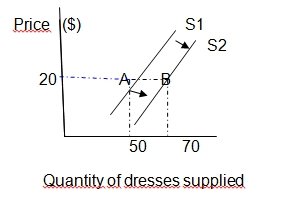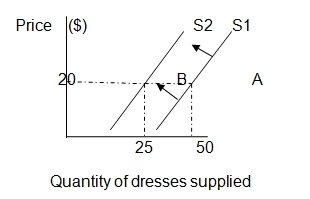Supply, Its Shifts, and How It Determines Prices
Supply refers to the ability and readiness of sellers to create and offer different quantities of a commodity at different prices, or during a certain phase (Arnold 2010). Similar to demand, supply can also change. The supply of a commodity can increase or go down. Supply increases when suppliers can produce and are ready to sell the good at each price.
For instance, sellers could produce and be ready to sell 50 dresses at $20 each in May, while in June they could have the capacity to produce and be willing to sell 70 dresses at $20 each. If supply increases, the entire supply curve shifts to the right as shown in fig (a).

Fig (a) Shifts when Supply Increases
On the other hand, supply decreases when sellers decide to produce and sell less of a good at all prices. For instance, sellers can produce and be willing to sell 50 dresses at $20 each in May, while in June, they could have the capacity to produce and be willing to sell 25 dresses at $20 each. If supply decreases, the entire supply curve shifts to the left as shown in fig (b).

Fig (b) Shifts when Supply Decreases
Many factors affect the supply of goods and interfere with supply curves. These factors include prices of other commodities, technology, prices of related resources, prospects of future price, the amount of sellers, government restrictions and taxes (Arnold 2010).
Price of Related Resources
Resources are central in the manufacture of goods. For instance, manufacture of tables needs wood. Table production becomes less expensive when the price of wood decreases. The profits from manufacturing tables increase as price of tables remains the same even ass cost reduces. Consequently, the economic incentive to manufacture more tables boosts.
Table manufacturers will make and sell an increased number of tables at each price. Therefore, the supply curve of tables will rise and this curve will shift to the right direction. Manufacture of tables becomes more expensive when the price of wood increases. As a result, the supply of tables will fall and the supply curve of tables will shift to the left direction.
Prices of Other Goods
Changes in price of a single commodity affect the supply of other goods. For instance, a company that manufactures plastic cups may start manufacturing glass cups, when the price of glass cups rise.
Quantity of Sellers
When an increased number of sellers begin selling a commodity due to high profits the supply curve moves to the right. When the number of sellers reduces due to losses the curve shifts to the left.
Technology
Technology refers to expertise in use of resources during production (Arnold 2010). An advance in technology refers to the capacity to yield increased output with a fixed measure of resources and this lessens costs in unit production.
For instance, lest assume that it takes $80 to create 20 units of a product. The cost of production per unit is $4. Suppose an advance technology can produce 40 units at a cost of $80, the cost of production falls to $2, for every unit. When the per-unit cost of production falls, quantity of supply increases.
Reduced costs of each unit boost profitability and these acts as an incentive to manufacturers to create more products. For instance, if farmers discover a way to grow peas using the same quantity of resources, cost of production per unit decreases, profits rise and farmers get the incentive to grow and sell more peas at each price. The curve of supply here shifts to the right.
Future Price Expectations
Producers may stop producing a commodity if they predict that it will sell at a higher price in prospect. In this situation, the supply curve will shift to the left. For instance, if wheat producers expect that the prices of wheat will rise next year, they may stop selling wheat pending next year. Equally, if wheat producers expect that the price of wheat will fall next year, they will sell more wheat this year.
Government Restrictions
At times, the government may decide to cut supply through imposing an import quota. For instance, a U.S. import quota on Chinese mobile phones will cut the supply of China mobile phones in America and the curve will shift to the left. Similarly, the supply of Chinese mobile phones increases upon removal of the import quota and the supply curve shifts to the right.
Taxes and Subsidies
Taxes increase the costs of commodities. When the rates of taxes rise, producers tend to produce less commodities and the curve shifts to the left. Besides, when the rates of taxes decrease, producers tend to produce more goods and the supply curve turns to the right.
Price Elasticity of Supply and Its Determinants
According to the law of supply, higher prices increase the amount of supply. The price elasticity of supply gauges how the amount of supply changes with price (Mankiw 1998). The supply of a product becomes elastic when the amount supplies responds to pr ice change significantly. Supply becomes inelastic when the amount supplied reacts to price changes insignificantly.
The flexibility of sellers to change the quantity of good they produce affects price elasticity. For instance, land at the beach is inelastic, since production of more land is impossible. On the other hand, commodities like cups, seats and radios have elastic supplies, since companies that produce them can extend the time for work in response to a higher price.
The main determinant of the price elasticity of supply in markets is the phase of time under consideration. Supply becomes more elastic after an extensive period than after a short duration (Mankiw 1998). Companies cannot change their quantity of production over a short phase.
Therefore, the amount supplied in the short run does not change in reaction to changes in price. On the other hand, companies may create new plants, or close old ones in the long-term. Besides, new companies can penetrate a market as the old ones end. Therefore, the amount supplied can react to price significantly, in the long-term.
Price elasticity of supply matters because it helps in determining how price is reacting to changes in demand. For instance, coffee demand may change due to introduction of substitutes at a lower price, or due to people’s sensitization about the negative impact of caffeine in coffee.
When the price elasticity of supply is high, the price changes insignificantly compared to when the price elasticity of supply is low. A slight change in price can make companies to cut the quantity supplied down to the lower quantity demand, with high price elasticity (Taylor 2006).
Therefore, the elasticity of supply affects the equilibrium price and change in quantity. After considering supply elasticity, we can foresee what happens to prices following a shift in the supply of a commodity. We can as well forecast what the impact of a change in demand on price.
References
Arnold, R 2010, Microeconomics, Cengage Learning, London.
Mankiw, G 1998, Microeconomics, Elsevier, New York.
Taylor, J 2006, Principles of macroeconomics, Cengage Learning, London.